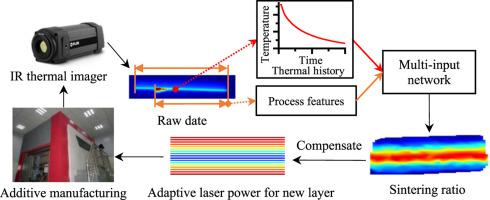Additive Manufacturing ( IF 10.3 ) Pub Date : 2021-04-20 , DOI: 10.1016/j.addma.2021.101986 Qi Zhong , Xiaoyong Tian , Xiaokang Huang , Cunbao Huo , Dichen Li

|
Process inconsistency in additive manufacturing (AM) leads to irregular quality of the final parts and obstructs its broader adoption in critical structural parts manufacturing. Especially in the manufacture of sizable components, detecting process changes in a real-time and accurate manner for potential corrective operations is crucial. This study aims to develop a feedback control system to reduce inconsistent part quality caused by heat accumulation differences. There are two significant challenges. 1) Thermal images suffer from a low signal-to-noise ratio. 2) Discrete local sintering information should be able to indicate the adjustments to the global temperature field. To tackle these challenges, a feedback model based on a multi-input neural network is proposed to evaluate the sintering status accurately by integrating the thermal history and process features. Subsequently, a layerwise feedback control strategy is proposed to process the discrete sintering status into the variation trend of part quality and ensure that the material has the desired thermal history during sintering. A controlled experiment is used to demonstrate the effectiveness of the proposed approach compared with its traditional counterparts, and the result illustrates the elimination of differences in heat accumulation by the proposed method.
中文翻译:

使用热历史的反馈控制来改善通过大规模粉末床熔合制造的零件的质量一致性
增材制造(AM)中的过程不一致会导致最终零件的质量不规则,并阻碍其在关键结构零件制造中的广泛采用。尤其是在大型组件的制造中,实时,准确地检测过程变化以进行潜在的纠正操作至关重要。这项研究旨在开发一种反馈控制系统,以减少由热量累积差异引起的零件质量不一致的情况。有两个重大挑战。1)热图像的信噪比低。2)离散的局部烧结信息应能够表明对整体温度场的调整。为了应对这些挑战,提出了一种基于多输入神经网络的反馈模型,通过结合热历史和过程特征来准确评估烧结状态。随后,提出了一种分层反馈控制策略,以将离散的烧结状态处理为零件质量的变化趋势,并确保材料在烧结过程中具有所需的热历史。通过对照实验证明了该方法与传统方法相比的有效性,结果说明了该方法消除了热量积聚的差异。提出了一种分层反馈控制策略,将离散的烧结状态处理成零件质量的变化趋势,并确保材料在烧结过程中具有所需的热历史。通过对照实验证明了该方法与传统方法相比的有效性,结果说明了该方法消除了热量积聚的差异。提出了一种分层反馈控制策略,将离散的烧结状态处理成零件质量的变化趋势,并确保材料在烧结过程中具有所需的热历史。通过对照实验证明了该方法与传统方法相比的有效性,结果说明了该方法消除了热量积聚的差异。











































 京公网安备 11010802027423号
京公网安备 11010802027423号